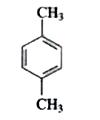Which of the following compounds has dipole moment approximately equal to that of chlorobenzene?
o-dichlorobenzene
m-dichlorobenzene
p-dichlorobenzene
p-chloronitrobenzene
The correct Answer is:B
To determine which compound has a dipole moment approximately equal to that of chlorobenzene, we will analyze the structures and dipole moments of the given options step by step.
Step 1: Understand the Dipole Moment of Chlorobenzene
Chlorobenzene (C6H5Cl) has a dipole moment due to the electronegativity difference between the carbon and chlorine atoms. The structure is a benzene ring with one chlorine atom attached, leading to a dipole moment directed towards the chlorine atom.
Step 2: Analyze the Given Options
We have four compounds to analyze:
1. Ortho-Dichlorobenzene
2. Meta-Dichlorobenzene
3. Para-Dichlorobenzene
4. Para-Chloronitrobenzene
Step 3: Draw the Structures
- Ortho-Dichlorobenzene: Two chlorine atoms are attached to adjacent carbons on the benzene ring.
- Meta-Dichlorobenzene: Two chlorine atoms are attached to carbons that are separated by one carbon atom.
- Para-Dichlorobenzene: Two chlorine atoms are attached to opposite sides of the benzene ring.
- Para-Chloronitrobenzene: One chlorine atom and one nitro group (NO2) are attached to opposite sides of the benzene ring.
Step 4: Determine the Dipole Moments
- Ortho-Dichlorobenzene: The dipole moments of the two Cl atoms will add vectorially. The angle between them is approximately 60 degrees, resulting in a net dipole moment.
- Meta-Dichlorobenzene: The dipole moments of the two Cl atoms will also add vectorially, but since they are at a 120-degree angle, the resultant dipole moment will be less than that of chlorobenzene.
- Para-Dichlorobenzene: The dipole moments of the two Cl atoms are directly opposite (180 degrees), which means they will cancel each other out, resulting in a net dipole moment of zero.
- Para-Chloronitrobenzene: The presence of the nitro group introduces a different dipole moment direction, which will not be similar to chlorobenzene.
Step 5: Compare the Dipole Moments
After analyzing the structures:
- Ortho-Dichlorobenzene has a dipole moment that is not equal to zero and is directed at an angle, making it the closest in dipole moment to chlorobenzene.
- Meta-Dichlorobenzene has a reduced dipole moment compared to chlorobenzene.
- Para-Dichlorobenzene has a dipole moment of zero.
- Para-Chloronitrobenzene has a different dipole moment due to the nitro group.
Conclusion
The compound that has a dipole moment approximately equal to that of chlorobenzene is Ortho-Dichlorobenzene.
Final Answer
Ortho-Dichlorobenzene (Option A)
Chlorobenzene (C6H5Cl) has a dipole moment due to the electronegativity difference between the carbon and chlorine atoms. The structure is a benzene ring with one chlorine atom attached, leading to a dipole moment directed towards the chlorine atom.
We have four compounds to analyze:
1. Ortho-Dichlorobenzene
2. Meta-Dichlorobenzene
3. Para-Dichlorobenzene
4. Para-Chloronitrobenzene
- Ortho-Dichlorobenzene: Two chlorine atoms are attached to adjacent carbons on the benzene ring.
- Meta-Dichlorobenzene: Two chlorine atoms are attached to carbons that are separated by one carbon atom.
- Para-Dichlorobenzene: Two chlorine atoms are attached to opposite sides of the benzene ring.
- Para-Chloronitrobenzene: One chlorine atom and one nitro group (NO2) are attached to opposite sides of the benzene ring.
- Ortho-Dichlorobenzene: The dipole moments of the two Cl atoms will add vectorially. The angle between them is approximately 60 degrees, resulting in a net dipole moment.
- Meta-Dichlorobenzene: The dipole moments of the two Cl atoms will also add vectorially, but since they are at a 120-degree angle, the resultant dipole moment will be less than that of chlorobenzene.
- Para-Dichlorobenzene: The dipole moments of the two Cl atoms are directly opposite (180 degrees), which means they will cancel each other out, resulting in a net dipole moment of zero.
- Para-Chloronitrobenzene: The presence of the nitro group introduces a different dipole moment direction, which will not be similar to chlorobenzene.
After analyzing the structures:
- Ortho-Dichlorobenzene has a dipole moment that is not equal to zero and is directed at an angle, making it the closest in dipole moment to chlorobenzene.
- Meta-Dichlorobenzene has a reduced dipole moment compared to chlorobenzene.
- Para-Dichlorobenzene has a dipole moment of zero.
- Para-Chloronitrobenzene has a different dipole moment due to the nitro group.
The compound that has a dipole moment approximately equal to that of chlorobenzene is Ortho-Dichlorobenzene.
Ortho-Dichlorobenzene (Option A)
Topper's Solved these Questions
- CHEMICAL BONDING (ADVANCED)Book:VK JAISWAL ENGLISHChapter:CHEMICAL BONDING (ADVANCED)Exercise:Level 3
Explore 77 Videos
- CHEMICAL BONDING (ADVANCED)Book:VK JAISWAL ENGLISHChapter:CHEMICAL BONDING (ADVANCED)Exercise:ONE OR MORE ANSWER IS/ARE CORRECT
Explore 78 Videos
- CHEMICAL BONDING (ADVANCED)Book:VK JAISWAL ENGLISHChapter:CHEMICAL BONDING (ADVANCED)Exercise:SUBJECTIVE PROBLEMS
Explore 64 Videos
- CHEMICAL BONDING (BASIC)Book:VK JAISWAL ENGLISHChapter:CHEMICAL BONDING (BASIC)Exercise:SUBJECTIVE PROBLEMS
Explore 54 Videos
Similar Questions
Knowledge Check
Which of the following compounds have a dipole moment?
A B
B C
C D
D
Which of the following compounds has a zero dipole moment ?
A B
B C
C D
D
Match the following:
 AA and DBB and CCC and EDB and E
AA and DBB and CCC and EDB and E
Which of the following compound has non-zero dipole moment
View SolutionWhich of the following pairs have same dipole moment
View SolutionWhich of the following has highest dipole moment?
View SolutionWhich of the following compounds has a zero dipole momnet ? .
View SolutionWhich of the following has no net dipole moment ?
View Solution